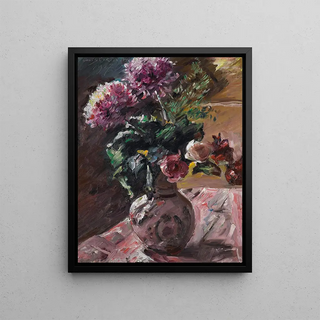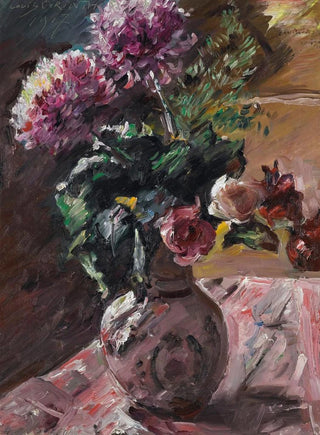Art print | Chrysanthemums and roses in a pitcher - Lovis Corinth


View from behind

Frame (optional)
In the world of art, some works manage to capture the very essence of nature's fleeting beauty. "Chrysanthemums and Roses in a Pitcher - Lovis Corinth" is one of those creations that transports us to a universe where the delicacy of flowers blends with the power of painting. This piece, created by the German painter Lovis Corinth, awakens in us a deep admiration for nature and its inexhaustible inspiration. As we contemplate this floral composition, the viewer is invited to immerse themselves in a silent dialogue between the fragility of the flowers and the robustness of the pitcher that holds them. The vibrant colors and harmonious shapes create an atmosphere that is both soothing and dynamic, conducive to reflection.
Style and uniqueness of the work
Lovis Corinth's style is distinguished by its bold and expressive approach. In "Chrysanthemums and Roses in a Pitcher," he manages to marry realism and impressionism, offering a unique vision of nature. The chrysanthemums, symbols of joy and beauty, are painted with such liveliness that they seem to almost vibrate on the canvas. The roses, for their part, add a touch of romanticism and softness, creating a perfect balance within the composition. The choice of colors, ranging from pastel shades to more intense hues, demonstrates an exceptional mastery of light and shadow. Each brushstroke reveals a sensitivity that transcends the simple floral rendering, inviting the viewer to feel the raw emotion of the scene. Thus, this work does not merely depict flowers; it evokes a true sense of life and movement.
The artist and his influence
Lovis Corinth, an emblematic figure of early 20th-century German painting, knew how to leave his mark on his era with his innovative style and artistic vision. Influenced by his contemporaries, notably the French impressionists, he developed a personal technique that allowed him to establish himself in the artistic landscape. Corinth did not limit himself to painting still lifes; he also explored various themes, ranging from portraits to landscapes. His approach to

Matte finish

View from behind

Frame (optional)
In the world of art, some works manage to capture the very essence of nature's fleeting beauty. "Chrysanthemums and Roses in a Pitcher - Lovis Corinth" is one of those creations that transports us to a universe where the delicacy of flowers blends with the power of painting. This piece, created by the German painter Lovis Corinth, awakens in us a deep admiration for nature and its inexhaustible inspiration. As we contemplate this floral composition, the viewer is invited to immerse themselves in a silent dialogue between the fragility of the flowers and the robustness of the pitcher that holds them. The vibrant colors and harmonious shapes create an atmosphere that is both soothing and dynamic, conducive to reflection.
Style and uniqueness of the work
Lovis Corinth's style is distinguished by its bold and expressive approach. In "Chrysanthemums and Roses in a Pitcher," he manages to marry realism and impressionism, offering a unique vision of nature. The chrysanthemums, symbols of joy and beauty, are painted with such liveliness that they seem to almost vibrate on the canvas. The roses, for their part, add a touch of romanticism and softness, creating a perfect balance within the composition. The choice of colors, ranging from pastel shades to more intense hues, demonstrates an exceptional mastery of light and shadow. Each brushstroke reveals a sensitivity that transcends the simple floral rendering, inviting the viewer to feel the raw emotion of the scene. Thus, this work does not merely depict flowers; it evokes a true sense of life and movement.
The artist and his influence
Lovis Corinth, an emblematic figure of early 20th-century German painting, knew how to leave his mark on his era with his innovative style and artistic vision. Influenced by his contemporaries, notably the French impressionists, he developed a personal technique that allowed him to establish himself in the artistic landscape. Corinth did not limit himself to painting still lifes; he also explored various themes, ranging from portraits to landscapes. His approach to






